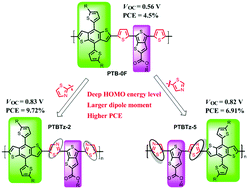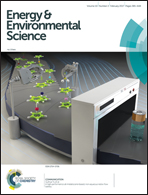Thienothiophene-based copolymers for high-performance solar cells, employing different orientations of the thiazole group as a π bridge†
Abstract
In this work, a thiazole moiety was employed as a π bridge incorporated into the backbone of quinoid polymers. The new strategy combined the characteristics of a thiazole unit with a deep HOMO energy level and a thieno[3,4-b]thiophene moiety (TT) with broad absorption. Two isomeric D–A copolymers, PTBTz-2 and PTBTz-5, were synthesized, with different orientations of the thiazole to the TT moiety. Interestingly, in comparison with PTBTz-5, PTBTz-2 exhibited an even lower HOMO energy level, a higher dipole moment, and a more planar molecular configuration, together with preferable phase domains and good intermixing with PC71BM. Thus, a superior PCE of 9.72% for the photovoltaic device was obtained, with a remarkable JSC of 16.84 mA cm−2, which is among the highest values for a single-junction solar cell. This is an increase of ∼40% in PCE in comparison with PTBTz-5 (PCE = 6.91%) and twice as much as for PBT-0F with thiophene as the π-bridge (PCE = 4.5%). This work not only provides a promising high-performance thiazole-containing system, but also reveals that the orientation of the asymmetric unit along the polymer backbone plays a crucial role and should be taken into account in future molecule design.



 Please wait while we load your content...
Please wait while we load your content...